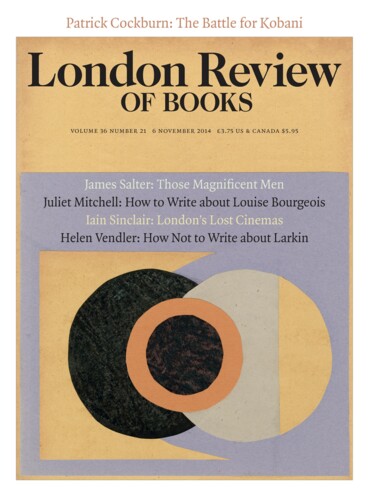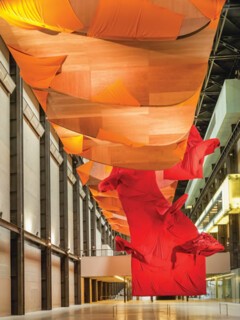It’s easy to see why Richard Tuttle’s work has a tendency to rile people – in particular people who insist on believing that sculpture, even if it no longer needs to be solid and substantial, should at least cling to material existence. From early on Tuttle seemed set on refusing such notions; his work came across as impromptu and elusive, a mirage of fragments, shadows and traces, portable, and hardly built to last. The immediate effect was to make minimalism look monumental, despite the fact that anti-monumentality was precisely what the New York minimalists – sculptors like Robert Morris, Richard Serra and Donald Judd – so polemically espoused. As Morris put it, they were bent on making neither objects nor monuments. Their art sought an in-between condition, a size, shape and presence intelligible only in the way a work behaved: our perceptions of it would, they hoped, be contingent on the vicissitudes of time and space. Can we step in the same river twice? If a work is made from propped-up sheets of lead, what happens when sagging sets in? Or if a cube’s assertively minimal structure is covered in mirrors, are we able to agree it’s the same, day in, day out? And then, as if these questions had promptly lost their interest, these same artists turned to remaking the monument itself.
Tuttle is a few years younger than the members of this celebrated generation; before taking on Tate’s Turbine Hall for his current exhibition (until 14 December) he consistently refused to work big. His interests expanded more conceptually than physically, to explore the neither/nor hybrid – ‘neither painting nor sculpture’ – that the minimalists had posited and suddenly left behind. By 1967, aged 26, Tuttle was making ‘paintings’ that did away with stretchers, and gave up on acrylic and oil. Instead each piece owed its homemade colour to time spent soaking in a tub of Tintex, the stuff of tie-dyed T-shirts and worse. And each owed its skewed shape – like letters or numbers on acid – to Tuttle’s fascination with language as a term or function of both poetry and sculptural form.
Behind his improvised process was the idea that, once dry, his shaped and coloured canvases – neither paintings nor sculpture – could be tacked to the wall any which way, wrinkles and all. As the late Scott Burton put it in 1969, the result was paradoxically as humble as it was grandiose: works like these ‘have no back, no front, no up or down, they may be attached to the wall or spread out on the floor’. Such a version of sculpture, in other words, relies wholly on the room in which it is situated, not least because there it can enact its misbehaviours at will.
Four of these 1960s cloth pieces are currently on view in London, looking a bit faded and bedraggled, yet still somehow lighter than air. They are the earliest components of the current three-part presentation of the artist’s work: a sparingly selected retrospective in the Whitechapel’s newly restored galleries; a purpose-built installation in the Turbine Hall; and a gorgeous catalogue, which not only covers both exhibitions but also illustrates a generous sampling of the textiles to which Tuttle has increasingly devoted himself. The result is a triumph.
As for the critical future of the exhibitions, I’m afraid I don’t know. I’m not sure it’s possible to be entirely certain about an enterprise that itself so aggressively embraces doubt. To choose a single title for its three components is one thing, but when that title is I Don’t Know: The Weave of Textile Language, there’s a risk things will go wrong. Apparently the idea was that the enterprise would embrace Tuttle’s default answer to Tate’s (necessary) questions about how his installation would find shape. But why let loose such an apparent non sequitur, such a loose linkage of uncertainty and its opposite? A few staff members at the press view wore small black and white ‘I don’t know’ badges: it seemed to me they were managing a problem, with a disavowal that wasn’t quite tongue in cheek. The risk Tuttle runs in the Turbine Hall is that his doubting title will become the voice of the exhibition, not least because ‘I don’t know’ is so quickly followed by ‘I don’t care’ or ‘I don’t like.’ Doubt can turn sour, and does. Scepticism has its merits, grumpy dismissal does not.
I’m not saying I know the solution to this problem – ideally there would be as many answers as viewers caught up by the show. Presumably engagement begins when – and if – the objects suspended at the far end of the Turbine Hall give themselves over to sensation and memory, and thus to thought. In my experience this didn’t happen easily or immediately, but sooner or later my doubts began to ease. The process started when I saw (or felt) the glow of a red and orange – a quite yellowy orange – that wouldn’t look out of place among the spices in a Delhi market. The aura comes from coloured fabric woven to order by a mill in the industrial Indian city of Surat, fabric that also included a third colour, a saturated midnight blue which is only just glimpsed beneath the red. Their role is to cover (in the case of the red) or to fail to cover (the yellowy orange) an arrangement of hanging plywood-covered steel forms. Tuttle named these components the ‘question mark’ (this is the piece in the centre, the one almost entirely shrouded in red) and the ‘airfoils’ (symmetrically flanking the question mark, these are four rather Judd-like tripartite pieces), which the orange fabric quite dramatically fails to shroud. Instead the material is tacked into place so as to fall away in pleats and billows, as if the airfoils are gaining momentum with a view to bursting free.
Is this description enough to suggest that Tuttle’s construction resembles nothing so much as an aeroplane straining to take flight? Yet, if the airfoils conjure an effect of streamlined engineering, the question mark summons something else again. It isn’t a body so much as a sign for a body – red and shrouded, shirred and puckered, it’s as phallic a shape as they come.
I don’t know whether allusions of this kind were intended, though no one could doubt that (as so often in male mythologies) energy, as well as mystery, are present in force. Equally there is no question that these are a function of Tuttle’s resolutely abstract language. What a happy coincidence it is that his installation went on view while the Malevich exhibition was, for a few days anyway, still hanging upstairs. On the Russian’s canvases rectangles climb and bank on white backgrounds that declare their flatness while still standing in for the vastness of space. The Black Square was there, hanging like an icon (or a Tuttle) high in the corner of a gallery, as was Suprematist Composition: Airplane Flying; both were first shown in 1915. Like so many pictures in the Malevich exhibition, the latter makes use of his beloved primaries: red and blue, of course, and an orange-yellow that echoes the aura of Tuttle’s draped cloth.
Something in the unexpected dialogue between the two exhibitions rings true. The great shapes in the Turbine Hall hark back to abstraction’s first utopias. To Malevich’s ‘Forward, comrade aviators!’ and even to Tatlin’s doomed re-creations of Leonardo’s flying machines. Abstraction constantly dreams of an exit from gravity. Whether Tuttle’s veiled aeroliths manage to take off – whether weightlessness and monumentality can be made into aspects of each other – is for each Tate visitor to say.
Send Letters To:
The Editor
London Review of Books,
28 Little Russell Street
London, WC1A 2HN
letters@lrb.co.uk
Please include name, address, and a telephone number.


